.
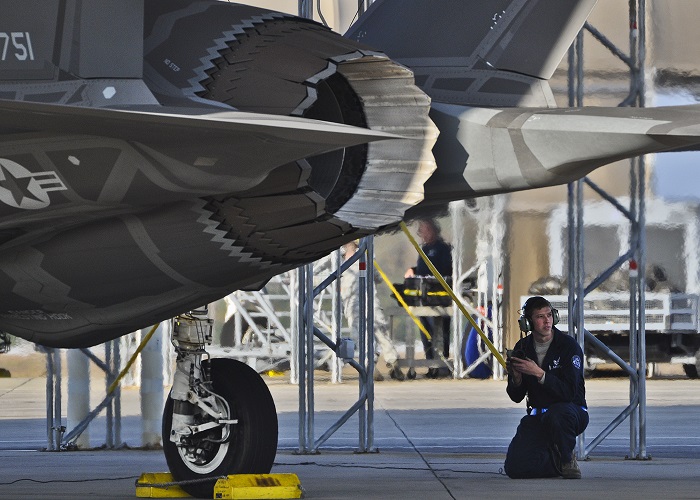
F-35A OUE events completed, success handed to AETC for review
.
EGLIN AIR FORCE BASE, Fla. -- A major step in the building the Air Force's F-35A Lightning II training program was accomplished when the 33rd Fighter Wing completed the training and flying portion of the service's operational utility evaluation on schedule Nov. 15.
Four pilots began training when the evaluation started Sept. 10, expecting it to last approximately 65 days. Six weeks of academic training and 24 sorties later, they are all fully-qualified F-35A pilots.
"We were able to conduct the flying portion in less than half the time than we planned for because things went so well with the flying, weather was good, maintainers were doing a great job getting jets out on the line and instructors were doing a good job of teaching these guys," said Col. Andrew Toth, 33rd Fighter Wing commander.
From no experience to fully qualified joint strike fighter pilot was the hallmark of the success according to wing leaders and instructor pilots.
Lt. Col. Eric Smith, 58th Fighter Squadron director of operations and first Air Force F-35 instructor pilot, recalled leading one of four OUE students, Maj. Joseph Scholtz, during an Instrument qualification course Nov. 9.
"Four weeks before the first pilot qualified, he was an A-10 pilot at Nellis Air Force Base (Nev.) and hadn't been involved much in the F-35 program other than what he read in the news about what was going on," said Smith. "The 33rd Fighter Wing testament to all of the hard work that has been going on here the last three and a half years of standing this place up, getting ready to train pilots, was when we took him out today and he pretty much flew a flawless F-35 mission. It's also a testament to Lockheed Martin partners involved in helping the Nomads, the men and women of 33rd, build a training system down here, develop it and go out and execute it."
During the flying portion, students demonstrated their ability to take off into restricted airspace, train flying in formation while airborne, conduct instrument approaches at a neighboring military base and clear the traffic pattern to land at Eglin. Their "check ride" was an hour-long flight culminating in full qualification to fly the F-35.
"Maintainers have done a fantastic job of generating sorties," Smith said.
The OUE provided the setting to test the 135 trained maintainers in generating up to six flights a day utilizing nine F-35As.
"Maintenance really stepped up to the plate," said Tech. Sgt. Matthew Burch. "They are learning the fifth generation way of maintenance quickly."
As they go along in their daily routine, maintainers find themselves rewriting joint technical data to pave the way for the future "play book" of maintaining F-35As alongside their contract logistics partners.
"Training conducted here at Eglin then enables the rest of the Air Force organizations to start standing up too, begin their training and test and evaluation piece - big steps in the F-35 program," said Toth.
Scholtz will give feedback, as others going through training do, before going back to his unit at Nellis, the 59th Test and Evaluation Squadron where the joint strike fighter will arrive next year.
The other qualified F-35A pilots trained during the OUE were Lt. Col. Brian O'Neill of Edwards Air Force Base, Calif., and Majors Cougar Wilson and Scout Johnston from the 33rd FW.
"A great part of all of this is the fantastic job of all the services. The OUE was a great couple of weeks flying, and we couldn't ask for any more," said Toth. "We are ready for the Joint Operational Test Team to write their report, provide us a quick-look out brief then formally brief our command on what they thought of the training system here. Once we receive the Air Education and Training Command's approval stating we are 'Ready For Training,' we can begin our first class."
Smith and his team of instructors are ready to train six pilots early next year as soon as they get that notice.
"We'll receive the training system for the block 1B operational flight program, the suite of software in the jets," he said. "It'll be our first class in this configuration. We are calling it a small group tryout, a contractual thing to make sure courseware developed is up to standards. It will take two months."
After its first year of training, the wing expects to see "normalcy" in its program.
"Concurrency of testing and training in the Air Force F-35 program means basic training of operational test pilots will happen first at Eglin in the near term," said Toth. "The pilots will then follow-on to Nellis or Edwards to conduct testing on new F-35 systems and capabilities before the wing adapts them in the training environment, resulting in the growth of the program becoming much more normalized. Meanwhile, the game plan for other military services and international partners will continue. Eventually there will be 2,100 maintenance students and 100 U.S. military F-35 pilots a year."
.
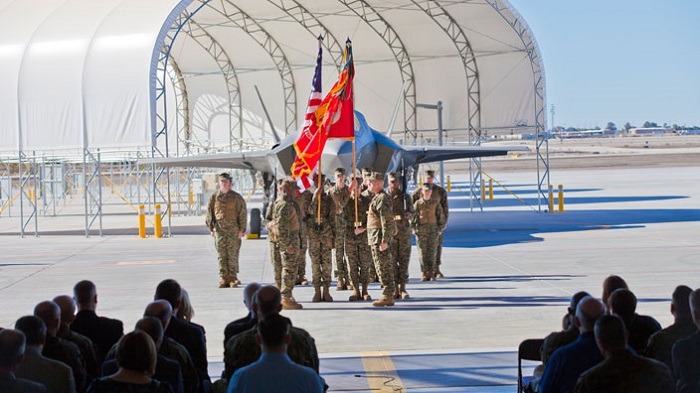
MARINE CORPS AIR STATION, YUMA, Ariz., Tuesday, November 20, 2012
Pratt & Whitney, a unit of United Technologies Corp. (NYSE: UTX), joined today with other industry partners to celebrate and offer congratulations to the United States Marine Corps for the official stand-up and re-designation of Marine Fighter Attack Squadron 121, the world's first operational squadron to fly the F-35B Lightning II aircraft.
During a ceremony today at Marine Corps Air Station Yuma, Ariz., representatives from Pratt & Whitney joined with esteemed aviation painter Keith Ferris, and his wife, Peggy, to present to the Marine Corps Ferris' painting "High Tide at Red Beach," which depicts the F-35B flying over the skies of Camp Pendleton, Calif.
"Hundreds of thousands of Marines have participated in amphibious landing and aviation training exercises at Red Beach on the Camp Pendleton complex, and many of them would instantly recognize that setting, which is wholly unique to the Marine Corps experience," said Ferris. "This painting captures the expeditionary and amphibious character of the Marine Corps, and the role of Marine Tactical Aviation in supporting the Marine on the ground. It was a delight to paint, and an even greater honor to present it to the Commandant of the Marine Corps on this historic occasion."
"This is yet another historic achievement for the F-35 program, and for the F-35B in particular," said Bennett Croswell, president, Pratt & Whitney Military Engines. "Just over a year ago, two F-35B aircraft accomplished their 'first ever' sea-based short take offs and vertical landings during trials aboard the USS Wasp, demonstrating to our STOVL customers the unique capabilities of the F135 STOVL propulsion system. Now we're celebrating another first for the program – the arrival of the first operational F-35B to Marine Corps Air Station Yuma, and the beginning of a new fifth generation fighter era for the Green Knights of VMFA-121."
The F-35B, a short takeoff and vertical landing multi-role fighter, is slated to replace the Marine Corps' F/A-18 Hornet, AV-8B Harrier and EA-6B Prowler. The F-35B's propulsion system, powered by Pratt & Whitney's F135 engine and the Rolls-Royce LiftSystem, allows the aircraft to operate from expeditionary airfields in remote, non-permissive environments with shorter runways, as well as amphibious vessels, contributing to the Marine Corps' role as the nation's expeditionary force-in-readiness.
The F-35 program includes three variants to meet the unique needs of the U.S. armed forces and the international participants in the program: the Conventional Take Off and Landing (CTOL), the Carrier Variant (CV), and the Short Takeoff and Vertical Landing (STOVL). To date, the F135 propulsion system has powered more than 358 vertical landings, 2,623 test flights producing more than 4,055 flight hours. Pratt & Whitney has delivered 41 CTOL/CV and 35 STOVL engines and related propulsion system hardware. The success of the F135 engine program validates the reliability, safety and performance of the engine.
Pratt & Whitney is a world leader in the design, manufacture and service of aircraft engines, space propulsion systems and industrial gas turbines. United Technologies, based in Hartford, Conn., is a diversified company providing high technology products and services to the global aerospace and building industries.
This press release contains forward-looking statements concerning future business opportunities and operational engine performance. Actual results may differ materially from those projected as a result of certain risks and uncertainties, including but not limited to changes in funding related to the F-35 aircraft and F135 engines, changes in government procurement priorities and practices or in the number of aircraft to be built; challenges in the design, development, production and support of advanced technologies; as well as other risks and uncertainties, including but not limited to those detailed from time to time in United Technologies Corp.'s Securities and Exchange Commission filings.
.
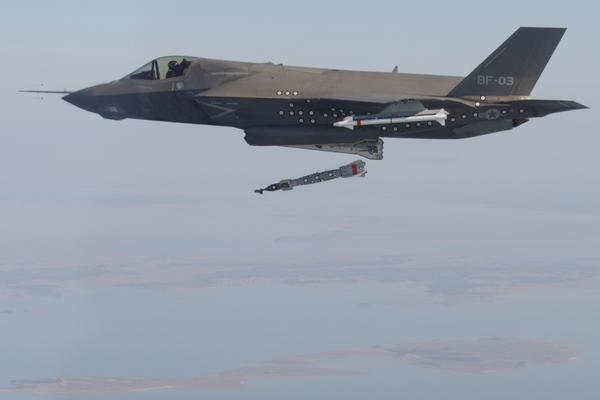
F-35B test aircraft BF-3, flown by Lt. Cmdr. Michael Burks, completed the first aerial weapons release of an inert 500-pound GBU-12 on Dec. 3, the first GBU-12 Paveway II Laser Guided Bomb release for any variant of the aircraft. BF-3 dropped the GBU-12 over the Atlantic Test Ranges from an internal weapons bay. The F-35B is the variant of the Lightning II designed for use by the U.S. Marine Corps, as well as F-35 international partners in the United Kingdom and Italy. The F-35B is capable of short takeoffs and vertical landings to enable air power projection from amphibious ships, ski-jump aircraft carriers and expeditionary airfields. The F-35B is undergoing flight test and evaluation at NAS Patuxent River, Md., prior to delivery to the fleet. (Photo courtesy of Lockheed Martin)
.
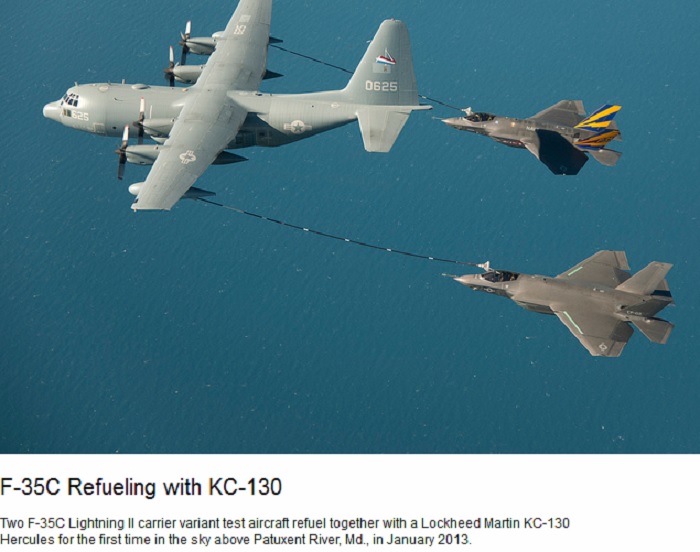
NAVAL AIR STATION PATUXENT RIVER, Md., Jan. 22, 2013 - For the first time, two Lockheed Martin F-35C Lightning II carrier variant (CV) test aircraft refueled together with a Lockheed Martin KC-130 Hercules in the sky above Patuxent River, Md., recently. The CV aircraft, known as CF-1 and CF-2, completed the milestone as part of an F-35 flight test program that will accomplish more than 1,000 flights in 2013. Later this year, Eglin Air Force Base, Fla., will receive its first CV aircraft joining the F-35 pilot and maintainer training program there. (Lockheed Martin photos by Andy Wolfe)
.
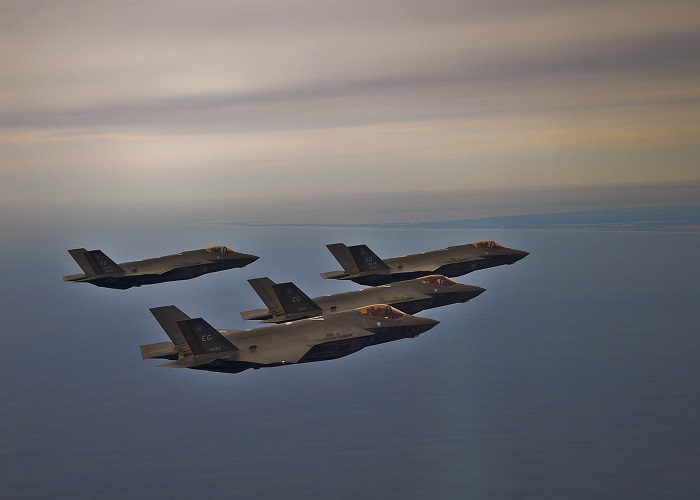
A four-ship of F-35A Lightning IIs returns to Eglin Air Force Base, Fla., after a sortie Feb. 1. Pilots with the 33rd Fighter Wing began flying the formation for the first time here last week. (U.S. Air Force photo/Capt. Edward Schmitt)
.
EGLIN AIR FORCE BASE, Fla. -- Increasing capability is becoming routine for the F-35 Lightning II team.
The 58th Aircraft Maintenance Unit produced a four-turn-four for the 58th Fighter Squadron flying Jan 31.
"The pilots flew four F-35As in the morning and the maintainers performed routine maintenance for airworthiness after landing. Then the crew chiefs 'turned' them around so the four jets could be flown in the afternoon," said Col. Andrew Toth, the commander of the 33d Fighter Wing and one of the aviators in the formation.
That was the first F-35 four-turn-four at the wing. Following up the successful flights, the team did the same Feb. 1 with a four-turn-two. During the Jan. 31 training flights, the pilots were using their advanced radar systems to track F-16 "adversaries" over the Gulf of Mexico.
Additionally, the maintainers had spare F-35As ready to go in the event of any issues in flight proving their ability to prepare the Air Force's newest fighter jet for basic pilot training.
While turning jets and flying multiple aircraft in formation is standard operations at an established flying training unit, for the 33d Fighter Wing, it was another step forward to self-sufficiency. Subsequently, it boosted morale.
"It was good to pull that off last week knowing recent weather can cancel flights," said Senior Master Sgt. Eric Wheeler, the production superintendent with 58th AMU. "I can't control the weather...everything else I control. The jets took off without any issues, the pilots flew their scheduled times. They all landed safely and the aircraft downloaded correctly."
Unique to the JSF, the downloaded data is inputted into the autonomic logistics information system that tracks the health of the jet in a computer based diagnostics and logistics system.
Contracted logistic support by Lockheed Martin is steadily giving way to 58th AMU crew chiefs as the Airmen become more proficient in maintaining the F-35A. LM will continue to support other variants and international partners.
.
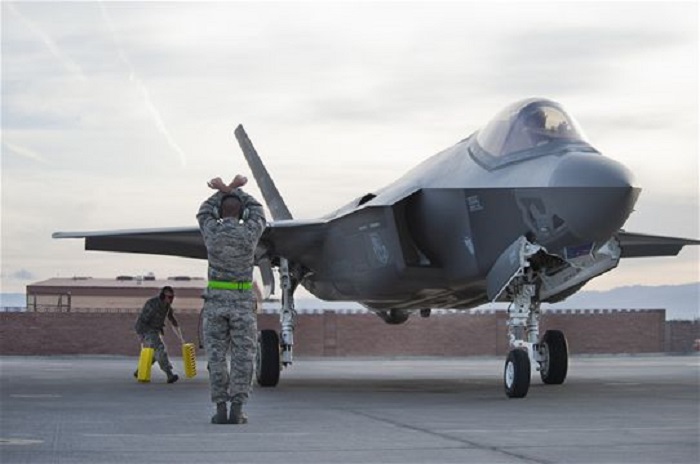
NELLIS AIR FORCE BASE, Nev., March 6, 2013 - A Lockheed Martin F-35 Lightning II lands at Nellis Air Force Base, Nev., March 6, 2013. The aircraft will be assigned to the 422nd Test and Evaluation Squadron and the aircraft will be used for development test support, force development evaluation, and supporting operational test aircraft at Edwards AFB, Calif. The aircraft has a maximum speed of more than Mach 1.6. (U.S. Air Force photos by Airman 1st Class Christopher Tam and Airman 1st Class Jason Couillard)
.
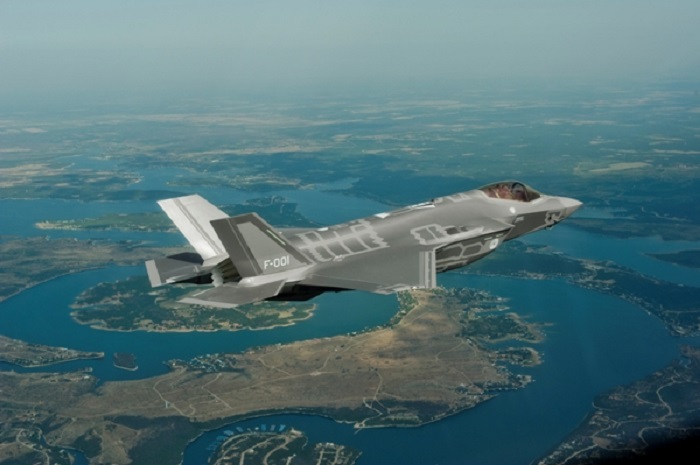
FORT WORTH, Texas, March 7, 2013 - The second Lockheed Martin F-35 Lightning II for the Netherlands rolled out of the F-35 production facility on March 2. This is the latest step in the production process leading to its eventual assignment to Eglin AFB, Fla., later this summer. The Netherlands is planning to use this conventional takeoff and landing (CTOL) jet, known as AN-2, for training and operational tests for pilots and maintainers. AN-2 will undergo functional fuel system checks before being transported to the flight line for ground and flight tests later this year. (Lockheed Martin photo by Tom Arobogast)
.
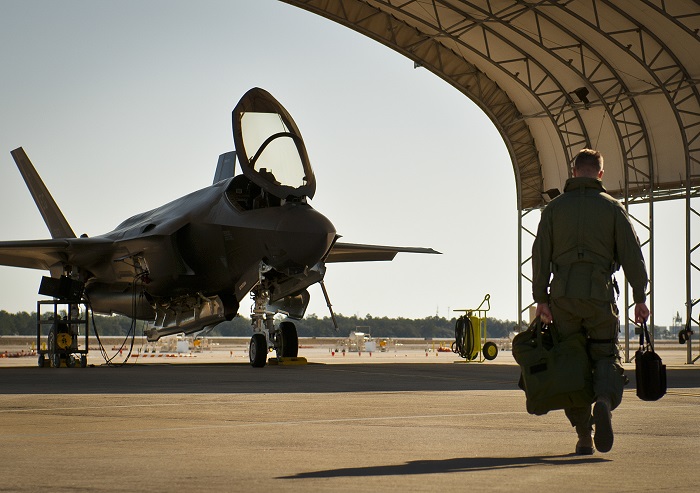
EGLIN AIR FORCE BASE, Fla., March 7, 2013 - Two officers from the operational test community are among the six pilots in the first F-35 Lightning II pilot training course after an Air Education and Training Command decision to start training here in January.
Lt. Col. Benjamin Bishop, the 422nd Test and Evaluation Squadron director of operations, is one of the students who flew their first sortie in March. He will transition his F-15E Strike Eagle warfighting skills to the F-35 before he returns to Nellis Air Force Base, Nev., next month. (U.S. Air Force photos by Samuel King Jr.)
.
EGLIN AIR FORCE BASE, Fla. -- Two officers from the operational test community are among the six pilots in the first F-35 Lightning II pilot training course after an Air Education and Training Command decision to start training here in January.
Lt. Col. Benjamin Bishop, the 422nd Test and Evaluation Squadron director of operations, is one of the students who flew their first sortie in March. He will transition his F-15E Strike Eagle warfighting skills to the F-35 before he returns to Nellis Air Force Base, Nev., next month.
"It's exciting, an honor to be a part of the future of airpower," he said. "The aircraft performed as I expected. It's a different feel and a different aircraft to get used to but both are easy to fly. Like any new aircraft, it's a different system to learn and I'm getting used to the basic maneuvers."
According to Nellis, jets began arriving the day their pilots flew their first sorties at Eglin. The 422nd TES will add the F-35A to its list of aircraft they execute command-directed operational test and evaluation for like the A/OA-10, F-15C, F-15E, F-16CM and F-22A hardware, software, and weapons upgrades prior to combat Air Force release. The squadron conducts tactics development, foreign materiel exploitation and special access programs to optimize system combat capability.
"We will develop the tactics, techniques and procedures for the F-35 and how it fits in the bigger airpower picture for the U.S.," said Bishop about the work ahead of him after graduating here leading OT for the fifth generation aircraft.
Capt. Brad Matherne is the other 422nd TES student transitioning to the joint strike fighter and he will return to Nellis to lead the new F-35 division. The structure in their organization has a division for the five other aircraft.
Like other students at the F-35 pilot training course in the 33rd Fighter Wing's Academic Training Center, Bishop began his temporary duty here with an orientation to the world of the joint strike fighter and custom fitting for the high-tech helmet.
"I feel like I'm back," Bishop said during his first week at Eglin. "It's a smooth transition."
He had been temporarily stationed here before with the 85th Test and Evaluation Squadron at the 53rd Wing.
"The academics section focused on the basic system of the aircraft and how it works - the hydraulics, electrical systems and avionics," said Bishop who had no exposure to the syllabus before coming to Eglin.
The first half of F-35 pilot training courses remain in the classroom and virtual environment at the ATC until the pilots are ready to step to the aircraft for the first time. On the flightline, they are required to taxi the aircraft and fly six sorties before completing their training. Combined in-class and in-air time is approximately three months.
Bishop's classmates, who are stationed at the 33rd FW, have been a part of the team building up the F-35 integrated training center and inevitably had more exposure to the syllabus before the first official class started.
"The simulators are our real success story," said Lt. Col. William Betts, 33rd Operations Support Squadron commander who has been on the initial cadre team since 2009. "It's refreshing to hear others say it is just like flying the F-35 (once they complete the first flight)."
Bishop echoed the same high fidelity of the full mission simulator here and said there is no comparison, especially when remembering his experience learning to fly the Strike Eagle.
"During my basic training in the F-15E back in 2000, the simulator was like a black and white T.V. screen hooked up to a cockpit," he said. "It shows how far we've come in (pilot) training. It's humbling for me to be around this world class environment."
When Bishop returns to Nellis, he will hone those flight hours as a student and develop a plan for his squadron to begin demonstrating the F-35's combat capabilities as software becomes available.
ACC's OT community has already paved the way for Bishop's team by standing up a unit at Edwards Air Force Base, Calif., where developmental test of the aircraft continues concurrently in the joint strike fighter program. He was able to greet three pilots from that unit in the ATC halls as they arrived in March to be a part of the second class. This pace should continue for the 33rd FW throughout 2013 with an estimate of 36 pilots graduating the course by the end of year.
ACC was able to get in on the Air Force's acquisition life cycle early to build their expertise with the aircraft by sending operational test pilots through the first few courses at Eglin. As the Air Force's declaration authority for F-35A Initial Operational Capability, the command will make a decision based on achieving sufficient levels of readiness in both capability and capacity.
Specific criteria established by the commander of ACC include the ability to conduct basic close air support, interdiction, and suppression/destruction of enemy air defense missions, with the targeting, payload, and other performance characteristics that entails.
There is currently no specific timeframe identified for anticipated IOC.
In July 2011, an Air Force Record of Decision proposed basing 36 F-35 fighter aircraft at Nellis between 2012 and 2020; 12 jets for operational testing /force development evaluation, 24 for weapon school training. Flight activities will occur at the base and the Nevada Test and Training Range.
The 422nd is a geographically separated unit of the 53rd Wing, headquartered here.
.
FORT WORTH, Texas, March 8, 2013 - The first Lockheed Martin F-35 Lightning II with a Center Wing Assembly (CWA) built at the Lockheed Martin facility in Marietta, Ga., was flown for the first time this week. The aircraft, known as BF-25, is an F-35B short takeoff/vertical landing variant that will be delivered to the U.S. Marine Corps at Yuma, Ariz. The CWA is a major structural component and represents approximately one quarter of the aircraft’s fuselage. Approximately 350 people work on the F-35 program in Marietta. In addition to building the CWAs, technicians also apply specialized stealth coatings to F-35 horizontal and vertical tail control assemblies and also coat spare and repaired aircraft doors, panels and covers. (Lockheed Martin photo by Angel DelCueto)

